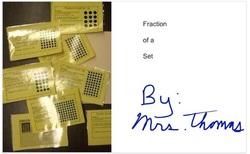
Here is a different video on fraction of a set that I found on a Singapore Math website. I didn't make it, but it shows how to use a bar model instead of circling dots.
Was this video helpful? Answer in the comments below.
|
|
 Here is a video I created that shows you how to find the fraction of a set. (Click the link, not the picture). Remember that you can pause and go back over any parts that you need to rewatch to help you with your homework and to study for your tests.
Here is a different video on fraction of a set that I found on a Singapore Math website. I didn't make it, but it shows how to use a bar model instead of circling dots. Was this video helpful? Answer in the comments below.
5 Comments
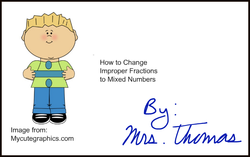 I've finally done it! Thanks to a class I went to today, I know how to create and post video tutorials for math concepts taught in class! Here is my first video (well, the second draft of it) on how to change improper fractions to mixed numbers (Click this link; not the picture above). You'll hear my voice explaining what to do as I write the example, step by step, on the "digital whiteboard." You can pause and replay the video as many times as you need to. Was this helpful? Answer in the comments below. 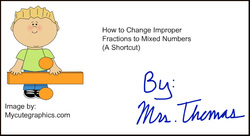 Here is my second video on the same topic. This is a different way to change improper fractions to mixed numbers (click the link; not the picture).
Which way do you like better? Are the videos helpful? Answer in the comments below. 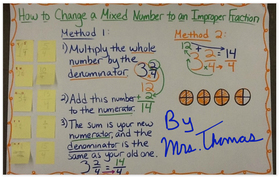 You asked for it, and here it is. Here is a video that will teach you how to change a mixed number to an improper fraction.
Was this video helpful? Please reply in the comments below.  For those kids who would rather study by reading the posters we made in class instead of replaying the video tutorial, here they are! To change a mixed number to an improper fraction, remember: Multiply then add. If you multiply the whole number by the fraction, you'll see how many fourths there are if you have 3 pies cut into fourths. The answer is 12 fourths. Add 2 more fourths, and you get 14 fourths. There are a few different ways to change an improper fraction to a mixed number. Method 1 is a long explanation, and method 2 is a shortcut, but they actually use the exact same steps.
Method 3 is the more traditional way to change 11/3 to a mixed number. Which way do you use to change an improper fraction to a mixed number? Answer in the comments below.  Fraction bars can help you understand what fractions look like. However, another great tool to use for mixed numbers (a fraction with a whole number) are number lines.
The VERY IMPORTANT thing to remember about using number lines, is you need to count the spaces between 0 and 1 so you know what the line is divided into! The question above asks you to find 1 1/2. What is the line divided into between 0 and 1? What is the denominator of all the fractions on this number line? Answer in the comments below. 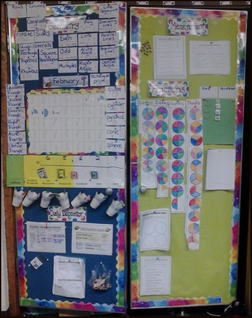 Our calendar math board is filling up! Here are some of the things we've learned to do at the Calendar board:
We have geometry vocabulary words. We have been looking at patterns in the dates every day when we put a different shape on the calendar. We have cut circles into fractional pieces, including thirds, fourths, fifths and sixths. We have named the fractions we see as improper fractions and mixed numbers. We have been multiplying two digit numbers by 100 and noticing that our answer always ends in 2 zeroes. We have been drawing figures with a given area by coloring squares. Then we found the perimeter. Today is March 28. Can you tell how many circles are colored if there are 28 thirds? Or, can you multiply by 28? Or, if you draw a long rectangle with 28 squares, can you tell the perimeter? Answer in the comments below. 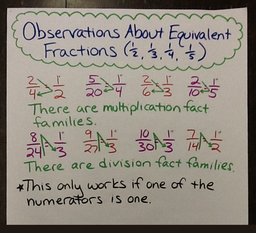 When fractions have a top number (called the numerator), we noticed that if you put them next to an equivalent fraction, you can see fact families!
Notice that the numbers in 1/4 and 1/2 go together. We can say that 2x2=4x1. We can say that 4 divided by 2 equals 2x1. If you look at the poster above, can you find any fact families? Write them in the comments below. 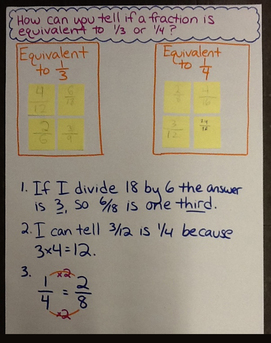 When using the plastic fraction bars, we noticed that one yellow bar is the same size and 4 purple bars. When two fractions are the same, we can say that they are equal or equivalent.
To tell if two fractions are equivalent, if you don't have the plastic fraction bars, there are a few different ways to find out if they are equivalent. Which way is your favorite, number one, two, three, or is there another way you can explain? Answer in the comments below. 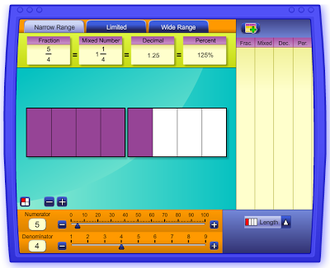 I found a couple more great fraction websites this weekend that we'll look at after the Book Fair: The first is a Build a Fraction tool. It's different from the fraction bars site because you can quickly make ANY fraction just by sliding to the number you want as your numerator and denominator. The bars appear for you. Then, you can click a button (see where it says "length?") to turn them into:
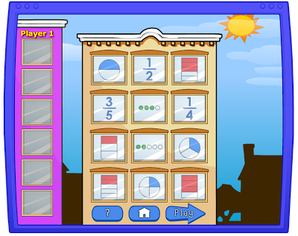 The other fraction website I found is a game!
First, when you go to this Fraction Game, under the word "Levels" you need to click on the box near the fractions (some of the other levels are for little kids). Next, under the word "Games," you can choose a difficulty level. If you want an EASY GAME where you match the fractions to each other, click on the 8 that's in an open window (see how above, all the windows are open?). If you want to play game that will CHALLENGE your memory, click on the closed window (all those windows above would be closed, and only open when you click on a pair). Finally, under "Players," you can choose two player mode if you want to play with a family member!  Square numbers are numbers you get when you answer a "doubles fact" problem. In other words:
1x1=1 2x2=4 3x3=9 4x4=16 5x5=25 If you have 25 squares, you can arrange them into one big square. 24 squares won't get you a big square and neither will 26, because those numbers aren't the answers to doubles facts. You can see that the length of the black 25 square is 5 and the width of 5. And 5x5=25. So you can actually find area either by counting the little squares inside, or you can multiply the length and width of the square! And shortcut to saying 5x5 is 5 squared is 25. So since today is March 8...it's Square Day's Eve! Have a happy Square Day tomorrow! |